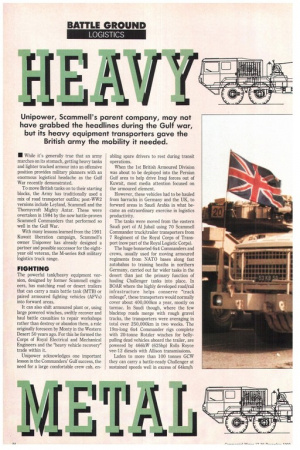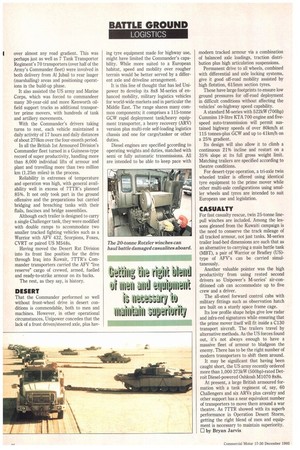Unipower, Scammell's parent company, may not have grabbed the headlines
Page 46

Page 48

If you've noticed an error in this article please click here to report it so we can fix it.
during the Gulf war, but its heavy equipment transporters gave the British army the mobility it needed.
• While it's generally true that an army marches on its stomach, getting heavy tanks and lighter tracked armour into an offensive position provides military planners with an enormous logistical headache as the Gulf War recently demonstrated.
To move British tanks on to their starting blocks, the Army has traditionally used a mix of road transporter outfits; post-WW2 versions include Leyland, Scammell and the Thornycroft Mighty Antar. These were overtaken in 1984 by the now battle-proven Scammell Commanders that performed so well in the Gulf War.
With many lessons learned from the 1991 Kuwait liberation campaign, Scammell's owner Unipower has already designed a partner and possible successor for the eightyear old veteran, the M-series 8x8 military logistics truck range.
FIGHTING
The powerful tank/heavy equipment version, designed by former Scammell engineers, has matching road or desert trailers that can carry a main battle tank (MTB) or paired armoured fighting vehicles (AFVs) into forward areas.
It can also shift armoured plant or, using large powered winches, swiftly recover and haul battle casualties to repair workshops rather than destroy or abandon them, a role originally foreseen by Monty in the Western Desert 50 years ago. For this he formed the Corps of Royal Electrical and Mechanical Engineers and the "heavy vehicle recovery" trade within it.
Unipower acknowledges one important lesson in the Commanders' Gulf success, the need for a large comfortable crew cab, en
abling spare drivers to rest during transit operations.
When the 1st British Armoured Division was about to be deployed into the Persian Gulf area to help drive Iraqi forces out of Kuwait, most media attention focused on the armoured element.
However, these vehicles had to be hauled from barracks in Germany and the UK, to forward areas in Saudi Arabia in what became an extraordinary exercise in logistics productivity.
The tanks were moved from the eastern Saudi port of Al Jubail using 70 Scammell Commander truck/trailer transporters from 7 Regiment of the Royal Corps of Transport (now part of the Royal Logistic Corps).
The huge bonneted 6x4 Commanders and crews, usually used for moving armoured regiments from NATO bases along fast autobahns to training heaths in northern Germany, carried out far wider tasks in the desert than just the primary function of hauling Challenger tanks into place. In BOAR where the highly developed road/rail infrastructure helps conserve "track mileage", these transporters would normally cover about 400,000Iun a year, mostly on tarmac. In Saudi though, where the few blacktop roads merge with rough gravel tracks, the transporters were averaging in total over 250,000km in two weeks. The 19m-long 6x4 Commander rigs complete with 20-tonne Rotzler winches for bellypulling dead vehicles aboard the trailer, are powered by 466kW (625hp) Rolls Royce vee-12 diesels with Allison transmissions.
Laden to more than 100 tonnes GCW they can carry a battle-ready Challenger at sustained speeds well in excess of 64km/h over almost any road gradient. This was perhaps just as well as 7 Tank Transporter Regiment's 70 transporters (over half of the Army's Commander fleet) were involved in both delivery from Al Jubail to rear laager (marshalling) areas and positioning operations in the build-up phase.
It also assisted the US army and Marine Corps, which was forced to commandeer many 30-year-old and more Kenworth oilfield support trucks as additional transporter prime movers, with hundreds of tank and artillery movements.
With the Commander's drivers taking turns to rest, each vehicle maintained a daily activity of 17 hours and daily distances of about 270km over the four-month period.
In all the British 1st Armoured Division's Commander fleet turned in a Guinness-type record of super productivity, handling more than 8,000 individual lifts of armour and plant and travelling more than two million km (1.25m miles) in the process.
Reliability in extremes of temperature and operation was high, with general availability well in excess of 7TTR's planned 85%. It not only took part in the ground offensive and the preparations but carried bridging and breaching tanks with their flails, fascines and bridge assemblies.
Although each trailer is designed to carry a single Challenger tank, they were modified with double ramps to accommodate two smaller tracked fighting vehicles such as a Warrior with AFV 432, Scorpions, Foxes, CVRT or paired US M548s.
Having moved the Desert Rat Division into its front line position for the drive through Iraq into Kuwait, 7TTR's Commander transporters carried the AFV "live reserve" cargo of crewed, armed, fuelled and ready-to-strike armour on its backs.
The rest, as they say, is history.
DESERT
That the Commander performed so well without front-wheel drive in desert conditions is commendable, both to men and machines. However, in other operational circumstances, Unipower concedes that the lack of a front driven/steered axle, plus hay ing tyre equipment made for highway use, might have limited the Commander's capability. While more suited to a European habitat, speed and mobility over rougher terrain would be better served by a different axle and driveline arrangement.
It is this line of thought that has led Unipower to develop its 8x8 M-series of enhanced mobility, military logistics vehicles for world-wide markets and in particular the Middle East. The range shares many common components; it comprises a 115-tonne GCW rapid deployment tank/heavy equipment transporter, a heavy recovery (ARV) version plus multi-role self-loading logistics chassis and one for cargo/tanker or other duties.
Diesel engines are specified ccording to operating weights and duties, matched with semi or fully automatic transmissions. All are intended to be able to keep pace with modern tracked armour via a combination of balanced axle loadings, traction distribution plus high articulation suspensions.
Permanent drive to all wheels, combined with differential and axle locking systems, give it good off-road mobility assisted by high flotation, 615nun section tyres.
These have large footprints to ensure low ground pressures for off-road deployment in difficult conditions without affecting the vehicles' on-highway speed capability.
A standard M-series with 522kW (700hp) Cwnmins 19-litre KTA 700 engine and fivespeed auto-transmission will permit sustained highway speeds of over 801(m/h at 115 tonnes-plus GCW and up to 41km/h on a 25% gradient.
Its design will also allow it to climb a continuous 21% incline and restart on a 35% slope at its full gross weight limit. Matching trailers are specified according to theatre conditions.
For desert-type operation, a tri-axle twin wheeled trailer is offered using identical tyre equipment to the prime mover while other multi-axle configurations using smaller wheels and tyres are intended to suit European use and legislation.
CASUALTY
For fast casualty rescue, twin 25-tonne linepull winches are included. Among the lessons gleaned from the Kuwaiti campaign is the need to conserve the track mileage of all tracked armour, not just tanks. M-series trailer load-bed dimensions are such that as an alternative to carrying a main battle tank (MBT), a pair of Warrior or Bradley (US)type of AFV's can be carried simultaneously.
Another valuable pointer was the high productivity from using rested second drivers so Unipower's M-series' air-conditioned cab can accommodate up to five crew and a driver.
The all-steel forward control cabs with military fittings such as observation hatch are built on a sturdy space frame cage.
Its low profile shape helps give low radar and infra-red signatures while ensuring that the prime mover itself will fit inside a C130 transport aircraft. The trailers travel by alternative methods. As the US forces found out, it's not always enough to have a massive fleet of armour to bludgeon the enemy. There has to be the right number of modern transporters to shift them around.
It may be significant that having been caught short, the US army recently ordered more than 1,000 373kW (500hp)-rated Detroit Diesel-powered Oshkosh M1070 8x8s.
At present, a large British armoured formation with a tank regiment of, say, 60 Challengers and six ARVs plus cavalry and other support has a near equivalent number of transporters to move them around a war theatre. As 7TTR showed with its superb performance in Operation Desert Storm, getting the right blend of men and equipment is necessary to maintain superiority. ID by Bryan Jarvis
























































































